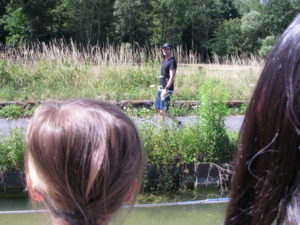Help, we are under attack by green sea-sausages!
48° 37′ 1.4928” N 4° 57′ 1.3216” E
July 10. – 2015
Fresh bread. Fresh water on the tanks. New starting battery for Ronja. We are ready for a new day. Lasse drives the car to Joinville and park it, at what we assume to be our next stop. It is not. More about this later.

In turns we take a walking- or jogging-tour along the river. The sailing here is a bit boring, so any kind of variation is wellcomed
Lasse will run to meet us from Joinville, 24 kilometres further down the canal. He manages to run 17 kilometres, before we have him on board again.
A full day of sailing. Most locks are ready, when we come to them. Only problem is a wild, green sausage-like plant that causes the sonar to signal constant danger – 0.0 meters below the keel – and which slows us down to something like 50 percent.
We are sailing through an underwater jungle of thick, spruce-like plants that spread out from the shore and appear to be in the process of conquering the entire channel. Only in a small stream in the middle, we can fight our way forward. Regularly we had to put Ronja at full speed astern, then full speed ahead. This will free us from the most aggressive of the green sea sausages. If the French do not find out how to keep these growths down, it may close the channel-tourism in a few years.
All this coming and going. Shortly after Lasse boarded after his run, Kirsten buckles her sandals to go ahead and explore the possibilities for accommodation by walking along the canal. While we struggle our way with only two knots between the aggressive aquatic plants, Kirsten talks to people along the canal and with captains of a few peniches.
Do not stay in Joinville, they say. It’s expensive, and it’s boring. They have found a place one kilometre before Joinville. The site is located “in the middle of nowhere” with a view of fields and forests. The facilities consist of a bench. No electricity. No water. No waste containers. In return frogs croak and the channel beckons with coolness and fish, so many that a three year old can capture them with a fishing-net.
The channel is not deep enough for us to get right to the shore, so we attach ourselves to the outside of a British couple, who have been here a long time and will be here for another 10 days. Together with them we block almost the entire channel. “There will be no more boats today. We have been away all year, and there are almost no boats. We have yet to see a commercial ship in the channel, ” the brits say from their peniche with oven and air conditioning. They point in one direction: Restaurant. They point in the another direction: Supermarket. Here we have everything. The rest is incredibly beautiful scenery.
We cannot help but wonder, how the french waterways are organised. Today we had two VNF employees following us at half the trip. On their mopeds they have followed us from lock to lock, from automated bridge to automated bridge. What job they have made, is hard to sy. They have not touched a hand. Just followed our movements from a distance.
One thinks involuntarily, though it might have been better to let the locks staffed, for it seems to us, that they use the same amount of labour, now that the locks are automated.
They should use resources to keep the channels dredged and free of green “sea sausages”. Instead it seems as if they let all indulge in an unrestrained consumption of labour. Anyway: We are in France.
We eat at the restaurant a few meters from the quayside. Excellent.
Log book: Today’s distance: 23 km. Sailed time from 10.00 to 15.30 = 5 ½ hours. Locks: 10. Weather: Sun all day. No heatwave. Just hot. Such as a summer in France should be. We stopped to check the weather, so we know nothing about current or future weather conditions. Channel sailing is not as dependent on the weather as ocean navigation.